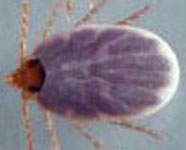TICKS
Boophilus annulatus
Ixodes ricinus
Hyalomma detritum
Haemaphysalis bispinosa
Amblyomma variegatum
Ticks are vectors of cattle fever, tick fever and several other pathogens that cause enlargement of spleen and discoloration of urine. Ticks are generally whitish to bluish-gray in colour with oval body wrapped in a tough and wrinkled skin. They prefer to suck blood from soft parts of the host body, like ear pinna or base of the tail. Being Arachnids, they have 4 pairs of legs, a pair of chelicerae modified for piercing and sucking and a pair of pedipalps. Female detaches from the host and lays eggs in soil, where the eggs hatch into a 6-legged larval stage called seed-tick. The seed tick grows in soil and finding an opportunity attaches on to the host and changing into a 4-legged nymph which eventually molts to become adult. Life cycle takes about 60 days.
Diseases transmitted
Bovine piroplasmosis (caused by the protozoan, Babesia species. Horse tick fever is caused by 2 species of Babesia. Theileriasis is a disease of goat and sheep caused by the protozoan, Theileria parva. Anaplasmosis is a protozoan disease caused by Anaplasma marginale. The Indian tick typhus is caused by Rickettsia conori in cattle in UP and Assam. Lyme disease is also transmitted by ticks. KFD (Kyasanur Forest Desease) is a viral disease transmitted by ticks.
Control: Ticks can be controlled by hand-picking or by spraying lindane, carbaryl, malathion or arsenic trioxide.
MITES
Sarcoptes scabei – Mange mite
Psoroptes equiovis; P. ovis; P. equi
Mites infect man, horse, goat, sheep, cattle, dog etc. They are very tiny, about 0.1 mm, oval in shape and pale to greyish in colour. Adult possess 8 stubby legs while larvae are 6-legged. Eyes are absent. Mouth parts are piercing and sucking type. Some species burrow in skin and make galleries or wounds which causes intense itching. Later, fluid-filled pimples are formed which are covered with scabs. These contain abundant mites and are the chief sources of infection by contact. Host may lose hairs due to infection.
Control: Mites can be controlled by the application of Benzyl benzoate, Benzocaine-ethyl p-aminobenzoate, Srobiton mono-ocleate, Lindane and sulphur ointment or by giving bath with lime-sulphur, nicotine and lindane.